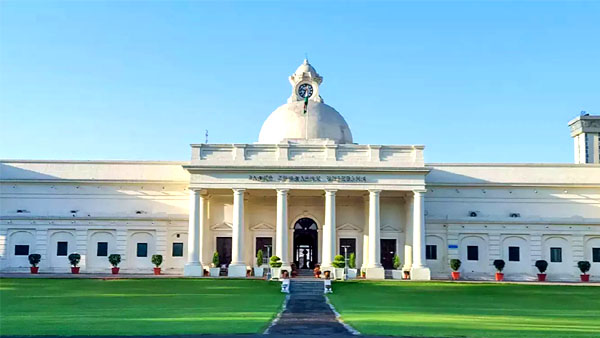By Dipak Kurmi
Come election season, India’s political landscape transforms into a theatre of promises, many of which are tailored to tug at the heartstrings of the electorate. Recently, election-bound Bihar announced a generous hike in pensions—from Rs 400 to Rs 1,100—for its elderly, widowed, and disabled citizens. Such declarations are not just anticipated but almost ritualised during polls. While these initiatives offer immediate relief and political mileage, they also raise a pressing question: should India continue down the path of fragmented welfare politics, or is it time to build a unified, rights-based, and economically sustainable social security architecture that both empowers citizens and fuels the economy?
The urgency of this question cannot be overstated. Over half of India’s population is under the age of 28, aspiring to a developed-nation future. By 2047, when India celebrates 100 years of independence, this very cohort will face the inevitable realities of aging, alongside millions of elderly who will need consistent and dignified support. The challenge is to move from short-term electoral giveaways to long-term systemic reforms that are technologically advanced, economically viable, and socially inclusive.
The International Labour Organisation’s Director-General recently commended India’s “cash and non-cash” social protection efforts. The ongoing ILO-Phase II survey reveals that India’s social protection net currently reaches over 100 crore beneficiaries, a staggering figure made possible by the cumulative weight of schemes from both central and state governments. By one estimate, there are over 34 major social protection programmes, 24 pension schemes, and numerous state-specific welfare initiatives.
Yet, the very scale of this network exposes its Achilles’ heel—fragmentation. The ILO’s own World Social Protection Report (2021) initially pegged India’s coverage at 24.4 percent, only to later revise it to 48.8 percent after factoring in state-level programmes. If an international agency with considerable resources struggles to reconcile the data, one can only imagine the bewilderment faced by ordinary citizens trying to navigate this labyrinth of entitlements.
The inefficiencies are systemic. Overlapping schemes, duplication of beneficiaries, repackaging of existing benefits under new names, and lack of interoperability create silos rather than synergy. For example, E-Shram registrations are designed for unorganised workers, while EPFO registrations cater to formal sector employees. The two systems often operate in parallel, creating boundaries that are problematic when workers’ careers straddle both informal and formal sectors. In many states, the proliferation of new welfare schemes often amounts to little more than old wine in new bottles, offering negligible differentiated value.
If India is to harness its scarce fiscal resources effectively, it must transition towards “One Nation, One Social Security Governance.” This model, if federated, flexible, and incentive-driven, can merge efficiency with inclusivity. It would not seek to centralise control to the exclusion of states but rather create a national backbone on which states can layer additional, locally relevant benefits.
The experience of other nations offers instructive lessons. Brazil’s “Fome Zero” programme established a Unified System of Social Assistance (SUAS) that regulates and organises the social assistance network across all states and municipalities, delivering coherent and equitable welfare services nationwide. South Korea, in the 1990s, overcame similar fragmentation by consolidating welfare under institutions like the National Pension Service and the National Health Insurance Service, providing streamlined access and universal coverage. India can draw inspiration from these transitions, adapting them to its own federal and socio-economic realities.
Technology, particularly the Digital India stack, provides a unique lever to accomplish this transformation. From Aadhaar-enabled Direct Benefit Transfers to the Aspirational Districts Programme, the country already has a robust digital ecosystem capable of delivering targeted and transparent welfare at scale. The PM Gati Shakti platform, designed to integrate infrastructure planning, could inspire similar integrative thinking for social security delivery.
Institutions like the Employees’ Provident Fund Organisation (EPFO) and the Employees’ State Insurance Corporation (ESIC) already demonstrate the potential for scale. The EPFO maintains around 30 crore accounts, with roughly 8 crore active contributors, and last year alone settled over 5 crore claims. The ESIC, too, has built deep roots in providing social insurance to millions. Leveraging these institutions as the primary vehicles for a unified welfare model could prevent duplication, reduce administrative costs, and ensure that entitlements are linked to unique, portable identifiers such as the Universal Account Number (UAN).
Imagine a system where any cash transfer—whether a state-level pension, a central government subsidy, or an emergency relief payment—is routed through a citizen’s UAN-linked account. This would not only simplify access but also allow for innovative linkages; for example, a percentage of pension payments could be automatically directed to provident fund contributions, insurance premiums, or even education allowances for grandchildren of the elderly. Such interlinking could transform welfare from mere consumption to an instrument of asset creation and intergenerational upliftment.
The G20 New Delhi Declaration has already underscored the need for “sustainably financed universal social protection coverage.” To achieve this in India, political consensus is essential. Welfare has historically been a politically charged subject, often used as a tool for electoral gain rather than nation-building. Yet, the sheer scale of India’s demographic transition demands that welfare policy be treated not as a vote-catching exercise but as a cornerstone of long-term economic planning.
Financial sustainability is key. Populist giveaways may be politically irresistible, but they often come at the cost of fiscal prudence. A unified, integrated social security system would allow better targeting, reducing leakages and freeing resources for investment in capacity building and skill development. By equipping citizens to earn and save, rather than perpetually depend on transfers, the system would grow the economic pie instead of fostering competition over its slices.
It is equally important to preserve the federal character of India’s governance. States must retain the autonomy to design schemes that reflect their unique social and cultural contexts. A unified governance model should thus be a partnership, where the centre provides the technological infrastructure, regulatory framework, and basic guarantees, while states innovate on top of this foundation.
This transition will not be without challenges. Data privacy and security must be rigorously safeguarded, given the sensitivity of personal and financial information. Interoperability between central and state systems will require significant investment in digital infrastructure and training. Resistance from entrenched bureaucratic structures and political stakeholders is inevitable. Yet, these hurdles pale in comparison to the transformative potential of a system that delivers dignity, security, and opportunity to every citizen.
India’s aspiration to be “Viksit Bharat” by 2047 hinges not just on GDP growth rates or infrastructure expansion but on the social contract it forges with its people. A robust, transparent, and equitable social security system is the foundation of that contract. Populist pensions and subsidies may win elections, but they cannot by themselves build a resilient nation. Only by unifying and modernising its welfare architecture can India ensure that its citizens are not just passive recipients of state generosity but active participants in a thriving, inclusive economy.
The political imagination that gave us Digital India must now be extended to Social Security India—a nation where no citizen is lost in the maze of scattered entitlements, where every rupee of welfare spending reaches its intended beneficiary, and where the promise of dignity in old age is not a campaign slogan but a lived reality. The choice is stark: continue down the well-trodden path of fragmented populism, or take the bold leap towards an integrated future that marries compassion with efficiency. In that choice lies the social and economic destiny of India in the twenty-first century.
(the writer can be reached at dipakkurmiglpltd@gmail.com)




